The Effect of Confined Granular Soil on Embedded PZT Patches Using FFT and Digital Static Cone Penetrometer (DSCP)
Abstract
:1. Introduction
2. Material and Methods
Piezoelectric Materials
3. Experimental Set-Up and Procedure
3.1. Test Model
3.2. Electro-Dynamic Vibrator and Instruments
3.3. Modal Parameter Estimation
3.4. Digital Static Cone Penetrometer
4. Results and Discussion
4.1. Natural Frequency Analysis
4.2. Cone Resistance of Confined Granular Fill
4.3. Analysis of Output Voltage
5. Conclusions
- (i)
- The voltage output from the PZT patch depends on the excitation frequency and placement of the PZT patch. For the same embedment depth, the peak voltage output in vertical direction is observed at 50 Hz, while in the transverse direction, it is obtained at 10 Hz.
- (ii)
- The depth of the compressive and tensile regions of the embedded PZT patch should be considered to obtain the maximum output voltage. For the same excitation frequency (f = 10–20 Hz), the maximum output voltage was obtained at a thickness of 20 cm for vertical vibration. For the transverse vibration, the maximum output voltage was obtained at a thickness of 30 cm.
- (iii)
- The cone resistance at various penetration depths indicates that voltage output increased proportionally with the cone resistance after excitation at the natural frequency. For excitation frequencies (f = 40–50 Hz), the voltage output increased from 22–45% for cone resistance in the 9–10% range. This variation indicates that the densification of fill and consequent increase in the cone resistance significantly impact improving the efficiency of the PZT patch.
- (iv)
- The natural frequency and damping loss factor significantly influence the voltage output of the PZT patch.
Author Contributions
Funding
Data Availability Statement
Acknowledgments
Conflicts of Interest
References
- Roundy, S.; Wright, P.K.; Rabaey, J. A study of low level vibrations as a power source for wireless sensor nodes. Comput. Commun. 2003, 26, 1131–1144. [Google Scholar] [CrossRef]
- Kim, H.W.; Batra, A.; Priya, S.; Uchino, K.; Markley, D.; Newnham, R.E.; Hofmann, H.F. Energy harvesting using a piezoelectric ”cymbal” transducer in dynamic environment. Jpn. J. Appl. Phys. 2004, 43, 6178. [Google Scholar] [CrossRef]
- Jung, H.J.; Kim, I.H.; Jang, S.J. An energy harvesting system using the wind-induced vibration of a stay cable for powering a wireless sensor node. Smart Mater. Struct. 2011, 20, 075001. [Google Scholar] [CrossRef]
- Wang, J.; Shi, Z.; Xiang, H.; Song, G. Modeling on energy harvesting from a railway system using piezoelectric transducers. Smart Mater. Struct. 2015, 24, 105017. [Google Scholar] [CrossRef]
- Zhang, Z.; Tang, L.; Xiang, H. Piezoelectric energy harvesting from bridge vibrations using different models for moving vehicles. J. Aerosp. Eng. 2019, 32, 04018141. [Google Scholar] [CrossRef]
- Erturk, A. Piezoelectric energy harvesting for civil infrastructure system applications: Moving loads and surface strain fluctuations. J. Intell. Mater. Syst. Struct. 2011, 22, 1959–1973. [Google Scholar] [CrossRef]
- Kumari, N.; Trivedi, A. Vibration Control of Flexible Retention Systems. In Advances in Computer Methods and Geomechanics; Lecture Notes in Civil Engineering; Springer: Singapore, 2020; Volume 2, pp. 529–539. [Google Scholar]
- Peigney, M.; Siegert, D. Piezoelectric energy harvesting from traffic-induced bridge vibrations. Smart Mater. Struct. 2013, 22, 095019. [Google Scholar] [CrossRef]
- Zhao, H.; Ling, J.; Yu, J. A comparative analysis of piezoelectric transducers for harvesting energy from asphalt pavement. J. Ceram. Soc. Jpn. 2012, 120, 317–323. [Google Scholar] [CrossRef]
- Chen, Y.; Zhang, H.; Zhang, Y.; Li, C.; Yang, Q.; Zheng, H.; Lü, C. Mechanical energy harvesting from road pavements under vehicular load using embedded piezoelectric elements. J. Appl. Mech. 2016, 83, 081001. [Google Scholar] [CrossRef]
- Roshani, H.; Dessouky, S.; Montoya, A.; Papagiannakis, A.T. Energy harvesting from asphalt pavement roadways vehicle-induced stresses: A feasibility study. Appl. Energy 2016, 182, 210–218. [Google Scholar] [CrossRef]
- Cahill, P.; Mathewson, A.; Pakrashi, V. Experimental validation of piezoelectric energy-harvesting device for built infrastructure applications. J. Bridge Eng. 2018, 23. [Google Scholar] [CrossRef]
- Ding, G.; Zhao, X.; Sun, F.; Wang, J. Effect of subgrade on piezoelectric energy harvesting under traffic loads. Int. J. Pavement Eng. 2018, 19, 661–674. [Google Scholar] [CrossRef]
- Kumari, N.; Trivedi, A. Factors Influencing Piezoelectric Response of Horizontally and Vertically Embedded PZT Patch in Confined Granular Fills. Adv. Mater. Sci. Eng. 2022, 2022, 7860273. [Google Scholar] [CrossRef]
- Xiang, H.J.; Wang, J.J.; Shi, Z.F.; Zhang, Z.W. Theoretical analysis of piezoelectric energy harvesting from traffic induced deformation of pavements. Smart Mater. Struct. 2013, 22, 095024. [Google Scholar] [CrossRef]
- Kumari, N.; Trivedi, A. Application of Semi-Active Control Strategy for The Wall Retaining Granular Fills. In Proceeding of the China-Europe Conference on Geotechnical Engineering 2018, SSGG, Vienna, Austria, 13–16 August 2018; Springer: Berlin, Germany, 2018; pp. 978–982. [Google Scholar]
- Zhang, C.; Wang, X.; Yan, Q.; Vipulanandan, C.; Song, G. A novel method to monitor soft soil strength development in artificial ground freezing projects based on electromechanical impedance technique: Theoretical modeling and experimental validation. J. Intell. Mater. Syst. Struct. 2020, 31, 1477–1494. [Google Scholar] [CrossRef]
- Humar, J.L.; Xia, H. Dynamic response analysis in the frequency domain. Earthq. Eng. Struct. Dyn. 1993, 22, 1–12. [Google Scholar] [CrossRef]
- Zimmerman, A.T.; Shiraishi, M.; Swartz, R.A.; Lynch, J.P. Automated modal parameter estimation by parallel processing within wireless monitoring systems. J. Infrastruct. Syst. 2008, 14, 102–113. [Google Scholar] [CrossRef]
- Singh, M.; Trivedi, A.; Shukla, S.K. Influence of geosynthetic reinforcement on unpaved roads based on CBR, and static and dynamic cone penetration tests. Int. J. Geosynth. Ground Eng. 2020, 6, 13. [Google Scholar] [CrossRef]
- Trivedi, A.; Singh, S. Cone resistance of compacted ash fill. J. Test. Eval. 2004, 32, 429–437. [Google Scholar] [CrossRef]
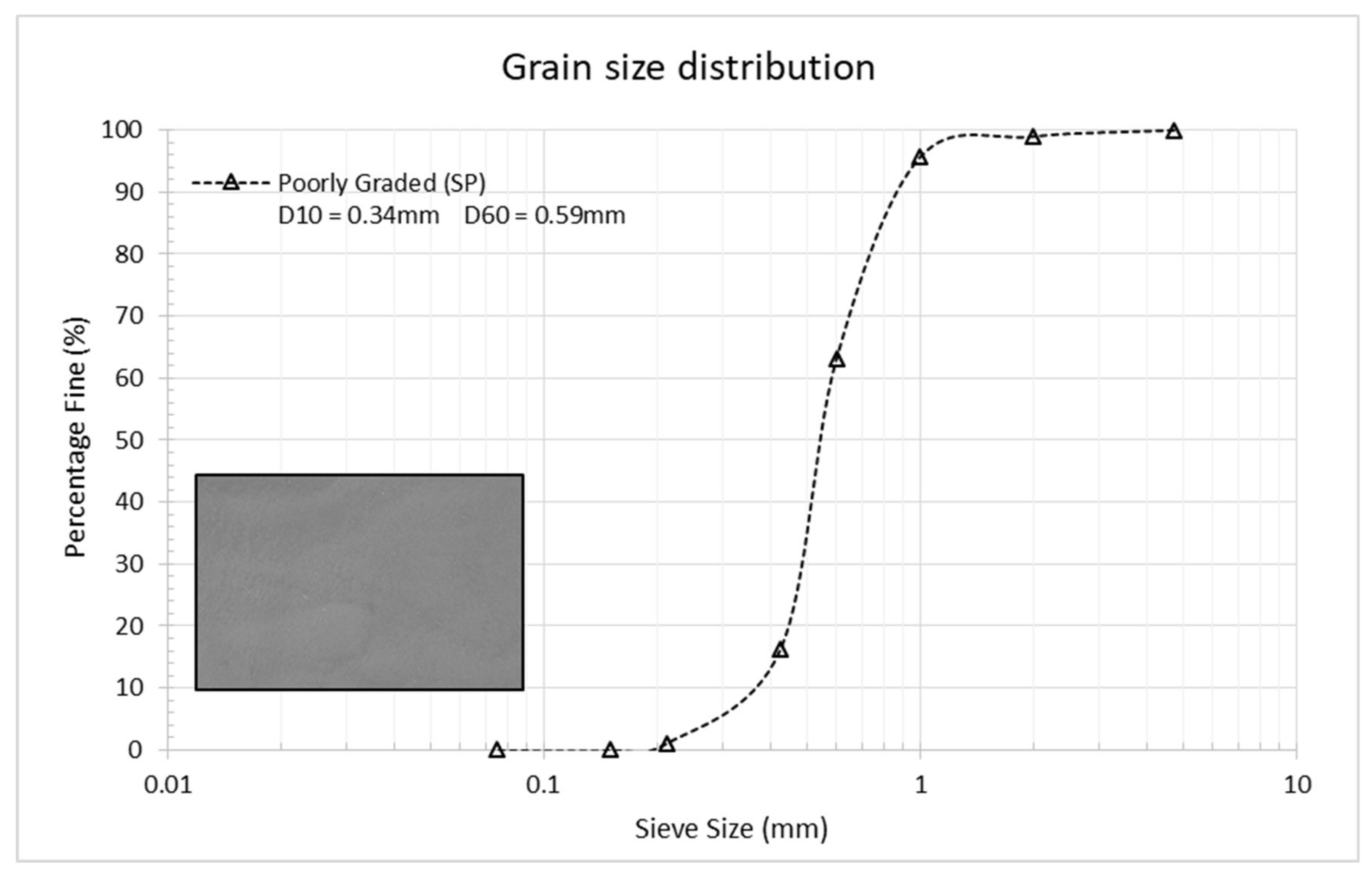
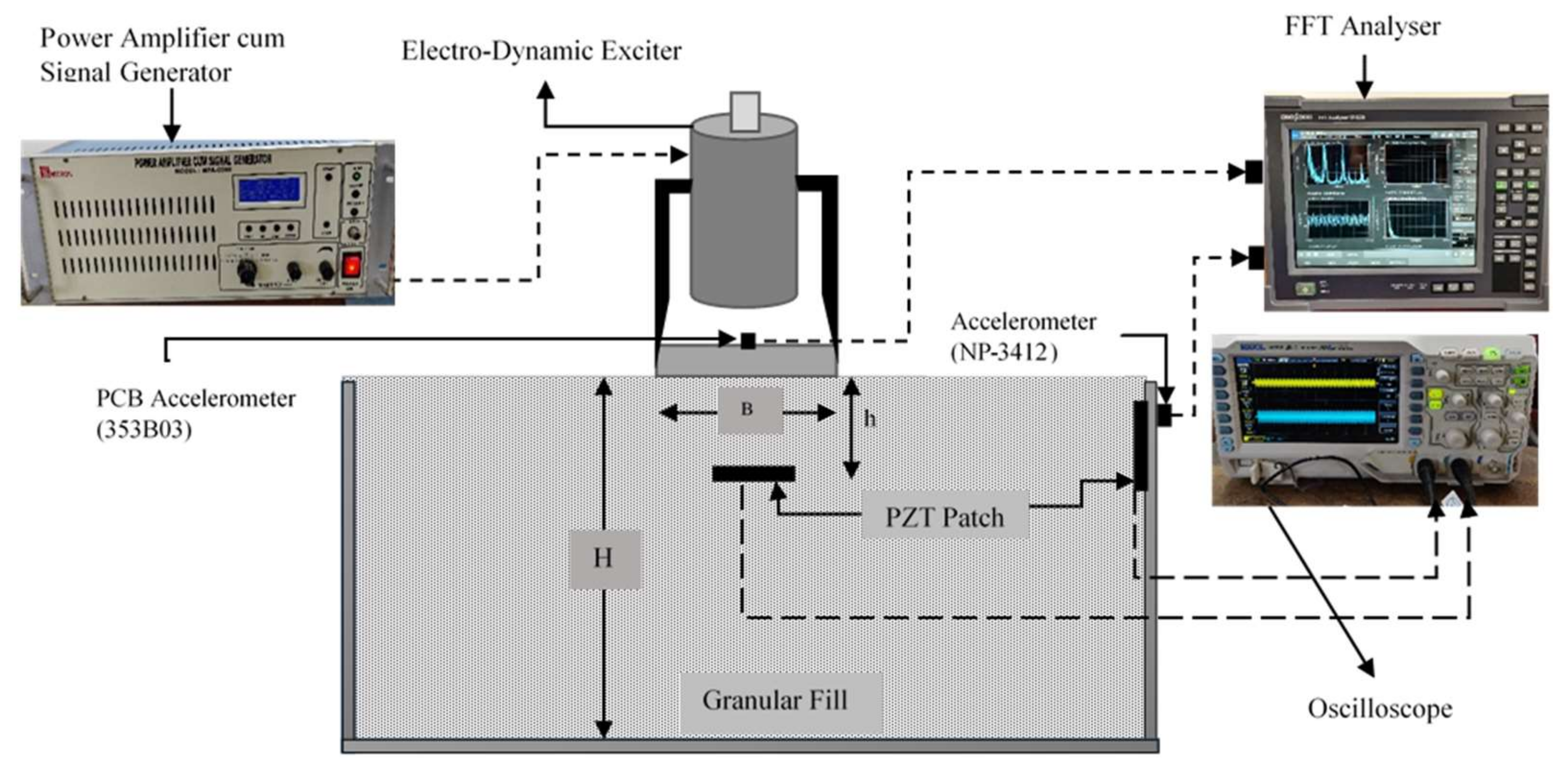


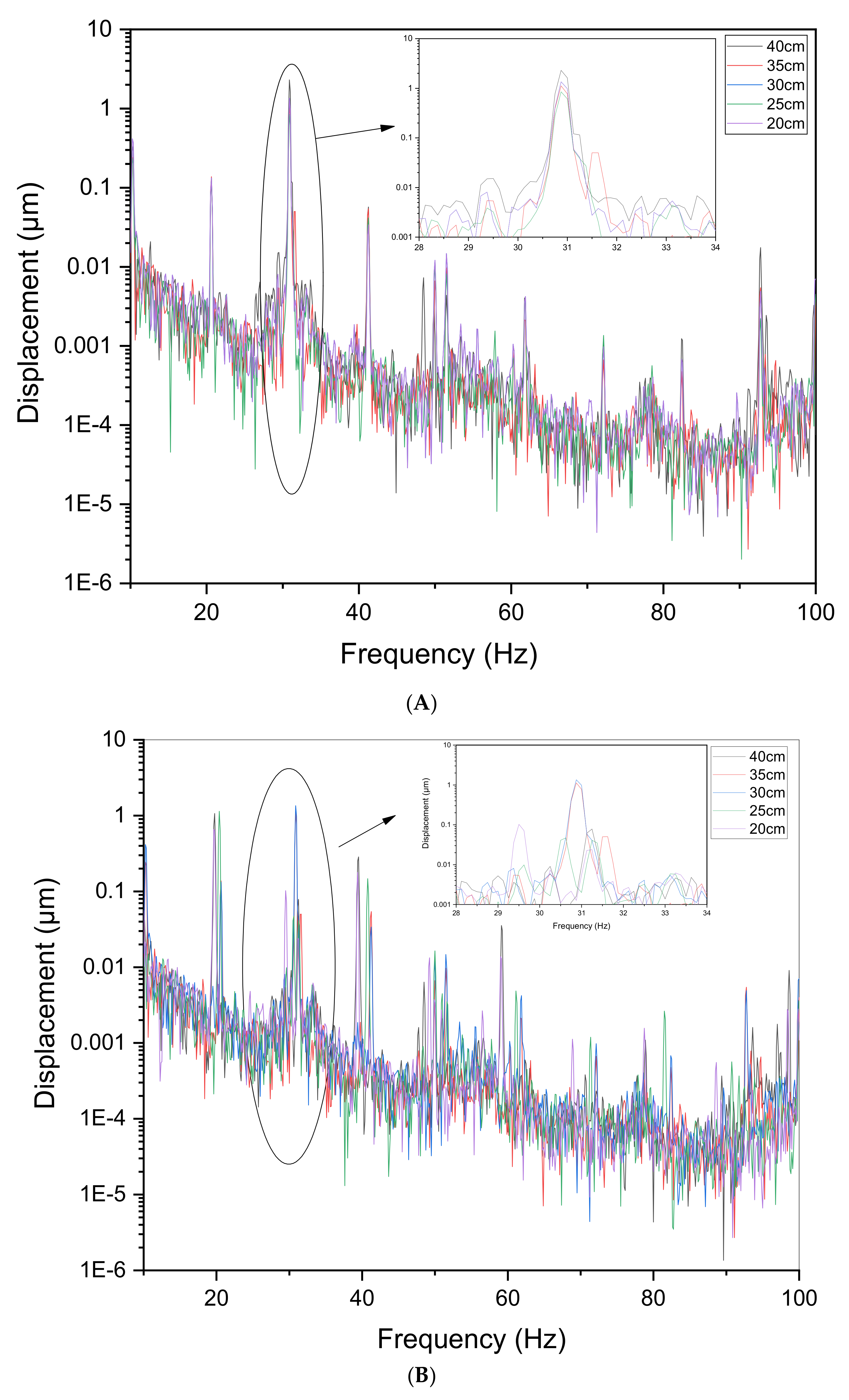
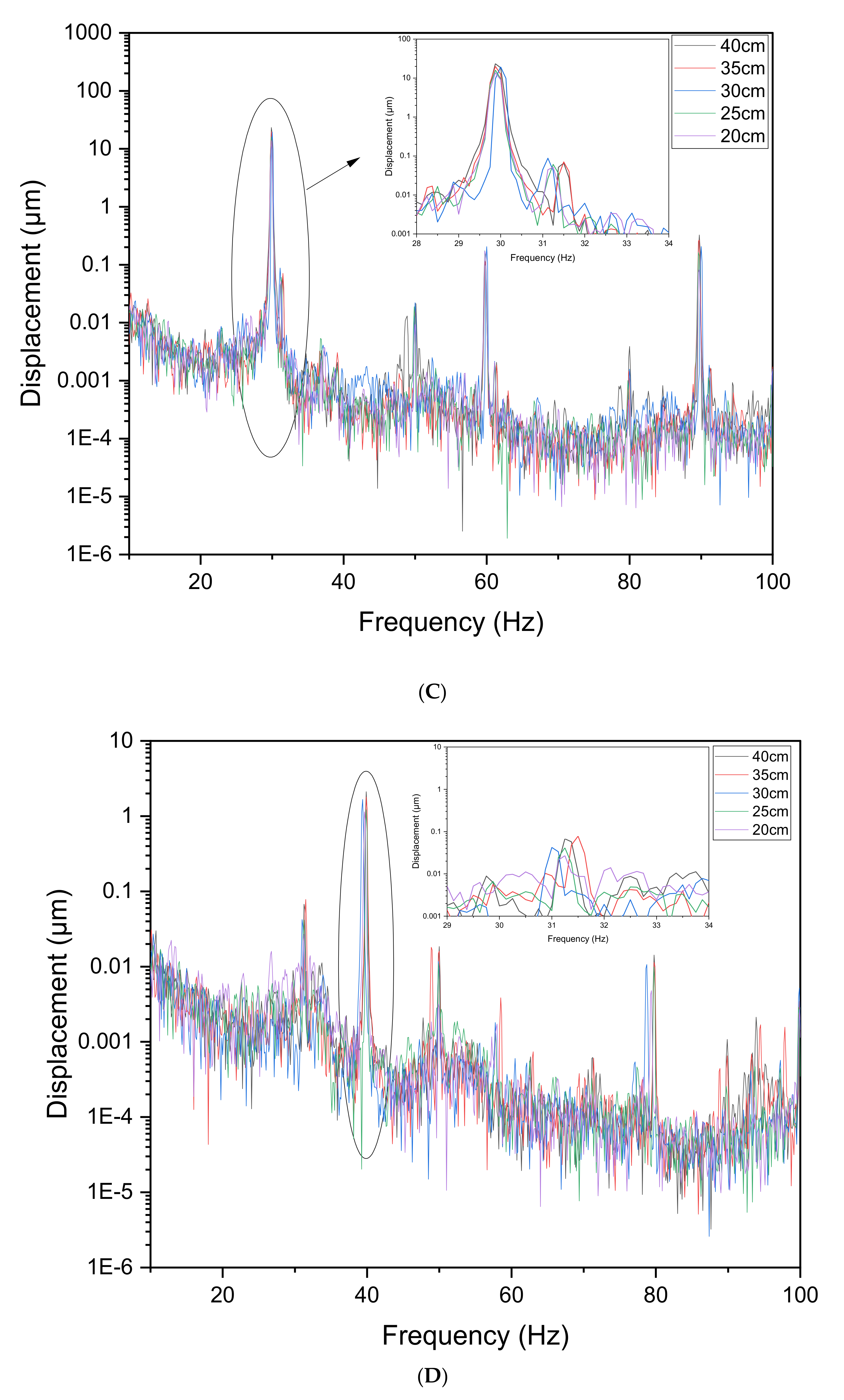
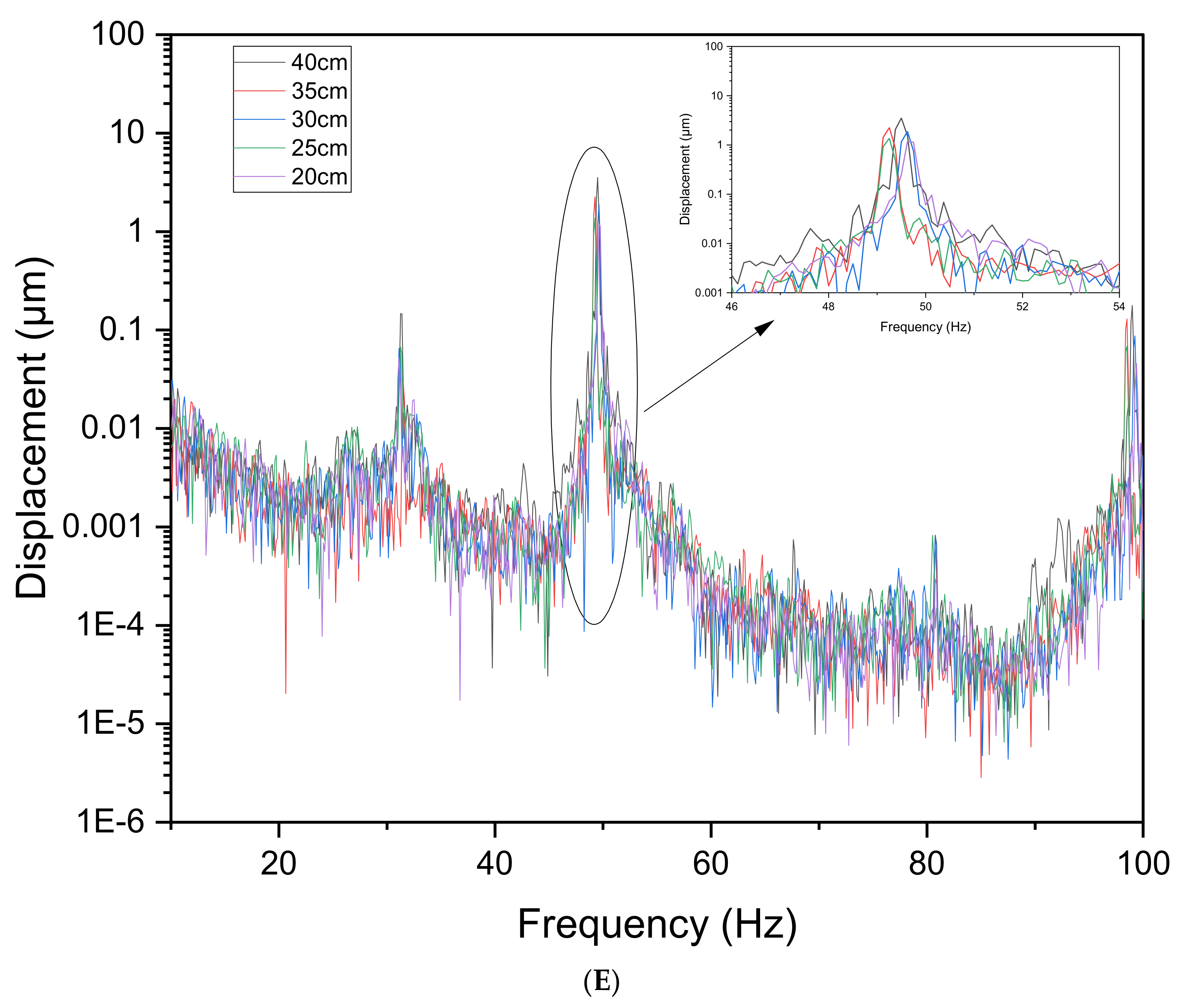
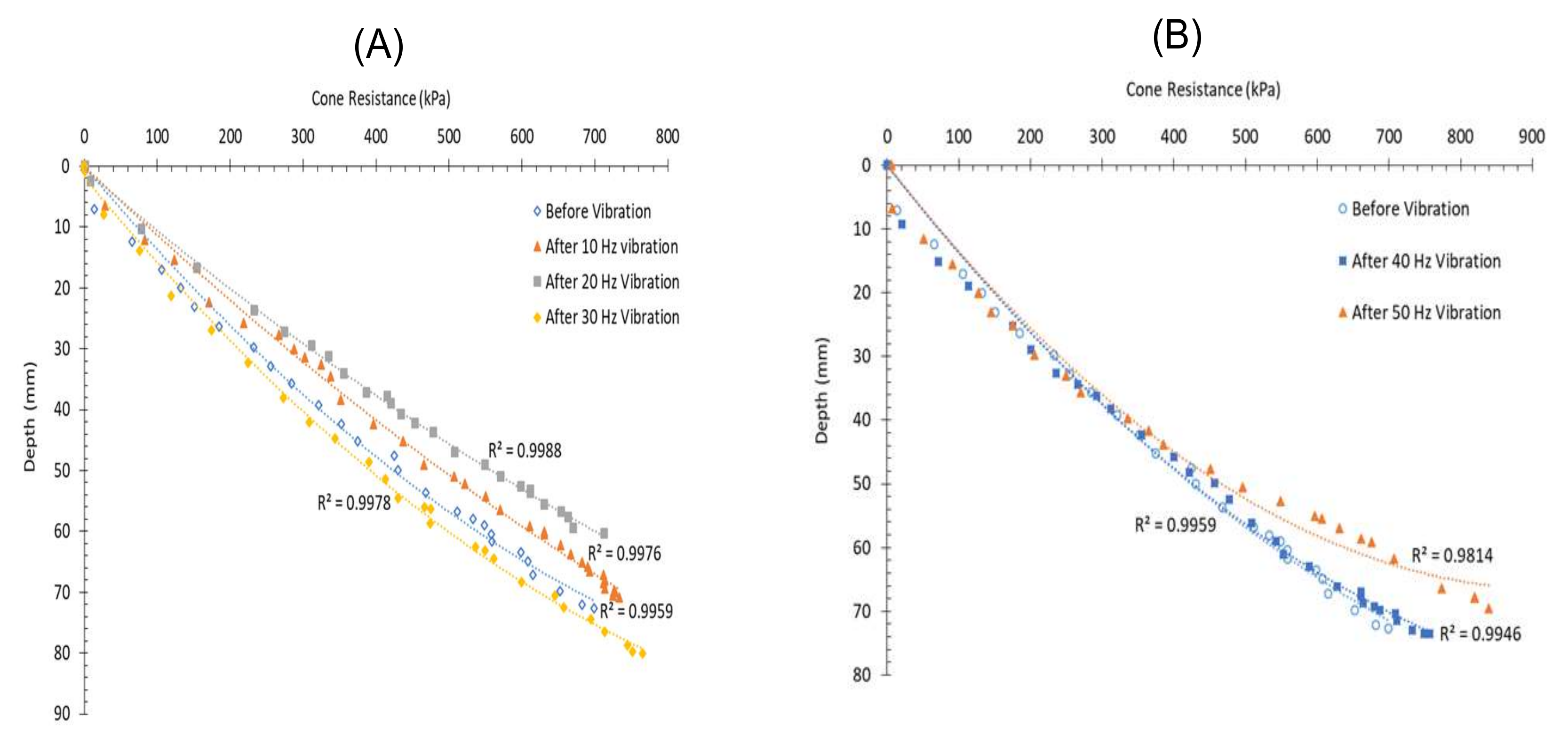
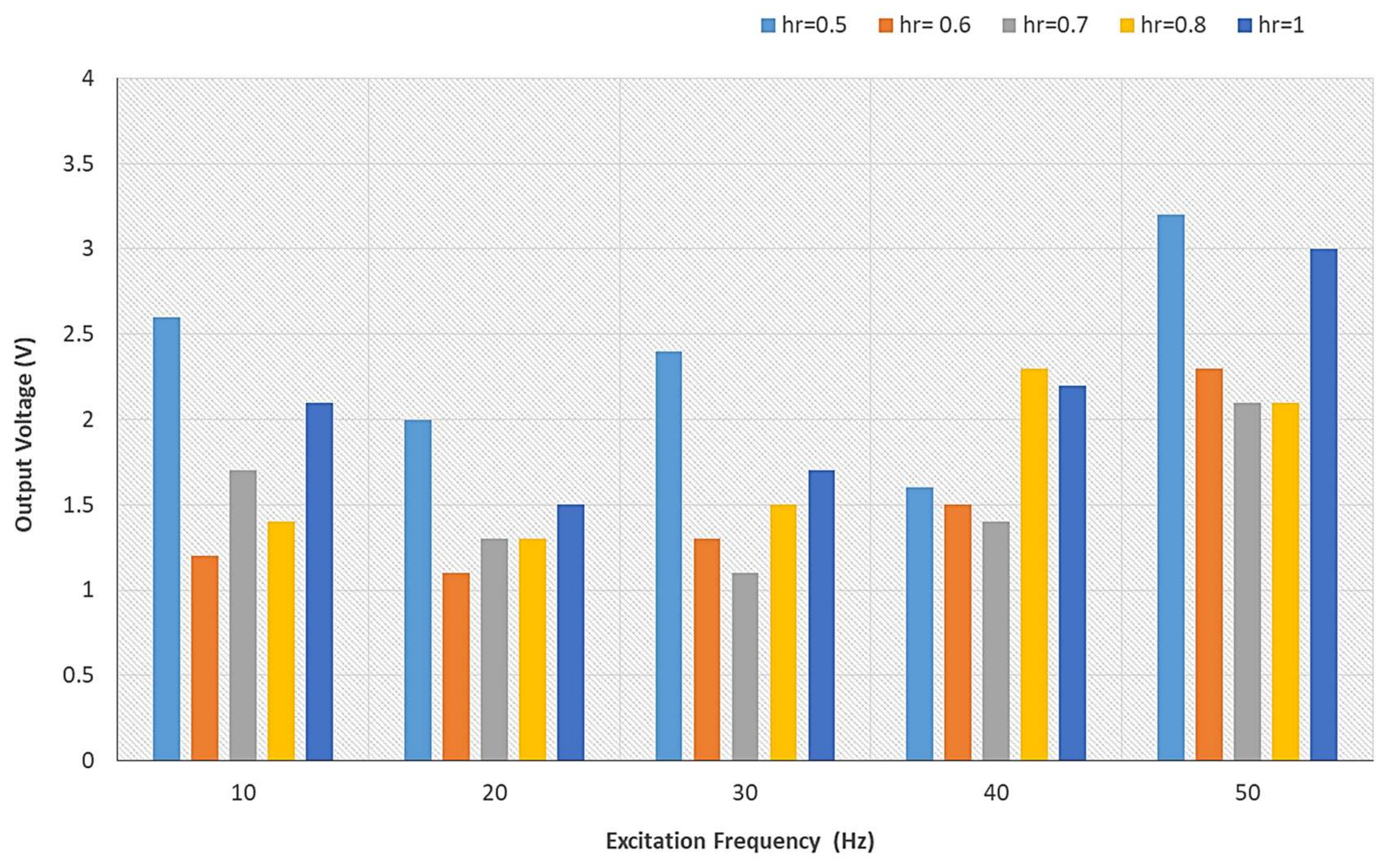
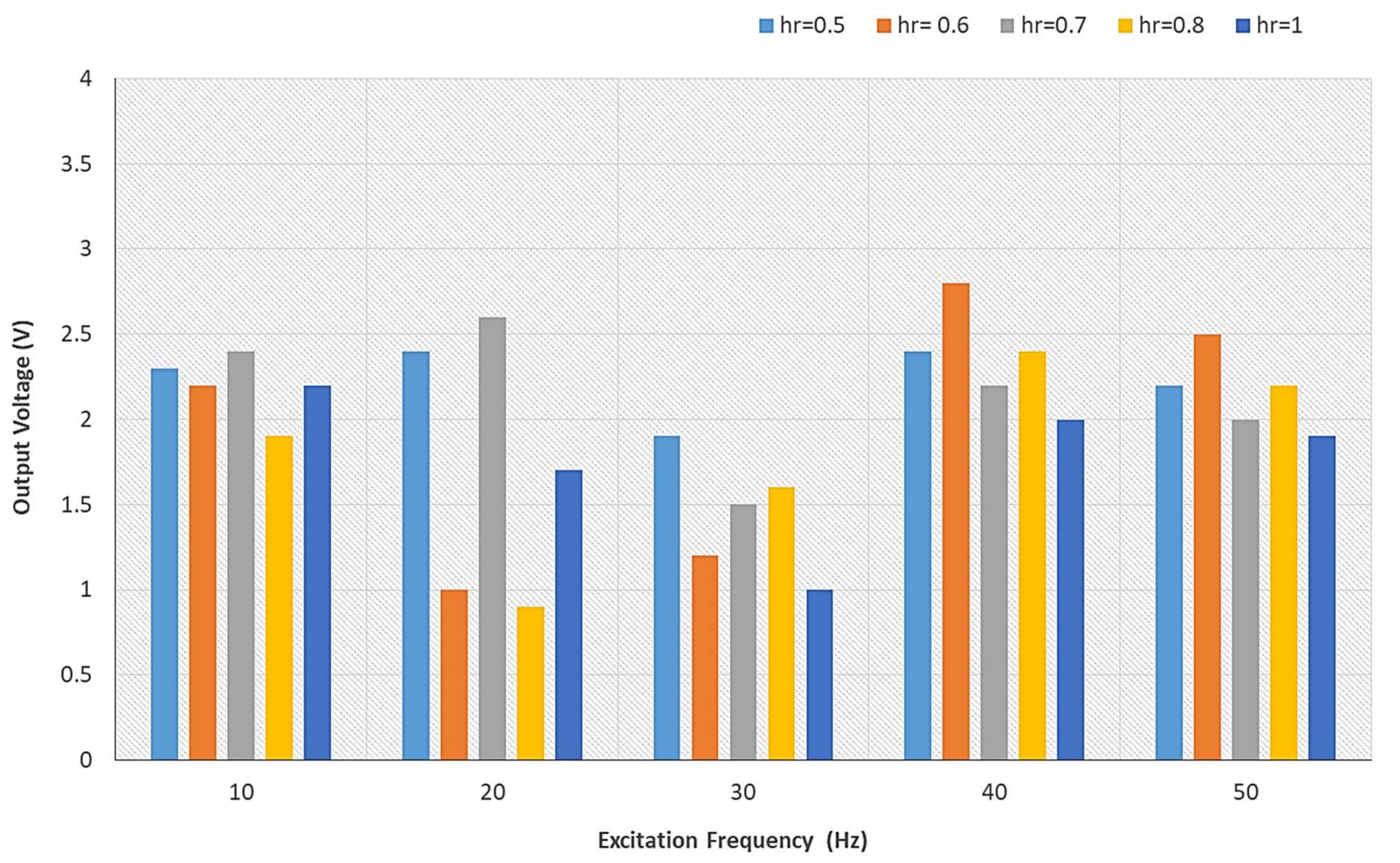
| Maximum Dry Unit Weight (kNm−3) | Degree of Compaction (%) | Specific Gravity | Optimum Moisture Content (%) | IS Classification |
|---|---|---|---|---|
| 18.4 | 96.7 | 2.5 | 13.91 | SP |
| Properties | Symbol | Magnitude |
|---|---|---|
| Dielectric constant | 3270 | |
| Dielectric loss | tanδ | 0.016 |
| Electromechanical coupling factor | 0.52 | |
| Piezoelectric charge constant (pC N−1) | d31 | −275 |
| Piezoelectric voltage constant (10−3 Vm N−1) | g31 | −9.5 |
| Young’s modulus (GPa) | Y | 61 |
| Unit weight (kNm−3) | γ | 7.2 |
| Input Excitation Frequency (Hz) | Vertical Vibration | Transverse Vibration | ||||
|---|---|---|---|---|---|---|
| Acceleration (µm/s2) | Velocity (µm/s) | Displacement (µm) | Acceleration (µm/s2) | Velocity (µm/s) | Displacement (µm) | |
| 10 | 2579 | 52 | 0.537 | 1243 | 20 | 0.290 |
| 20 | 913.26 | 0.759 | 0.007 | 77.128 | 1 | 0.008 |
| 30 | 272,000 | 1441 | 5.90 | 815,000 | 4389 | 18.33 |
| 40 | 103,000 | 233 | 0.93 | 57,920 | 299 | 1.19 |
| 50 | 2102 | 46 | 0.023 | 1766 | 45 | 0.018 |
| Excitation Frequency (Hz) | 10 | 20 | 30 | 40 | 50 |
| Natural frequency (Hz) | 31 | 31 | 30 | 32 | 49 |
| Damping loss factor (ξ) | 0.121 | 0.127 | 0.132 | 0.176 | 0.122 |
| Exciting Frequency (Hz) | α | β | R2 |
|---|---|---|---|
| 10 | −3 × 10−5 | 0.1157 | 0.9976 |
| 20 | −3 × 10−5 | 0.1035 | 0.9988 |
| 30 | −7 × 10−5 | 0.1539 | 0.9978 |
| 40 | −6 × 10−5 | 0.1439 | 0.9946 |
| 50 | −8 × 10−5 | 0.1432 | 0.9814 |
| Depth Ratio (hr) | Input Excitation Frequency (Hz) | Voltage Output in Vertical Direction (Vv) | Efficiency (%) | Voltage Output in the Transverse Direction (Vt) | Efficiency (%) |
|---|---|---|---|---|---|
| 0.5 | 10 | 2.6 | 2.3 | ||
| 20 | 1.2 | 54 | 2.2 | 4.3 | |
| 30 | 1.7 | 35 | 2.4 | 4.3 | |
| 40 | 1.4 | 46 | 1.9 | 17.4 | |
| 50 | 2.1 | 19 | 2.2 | 4.3 | |
| 0.6 | 10 | 2 | 2.4 | ||
| 20 | 1.1 | 45 | 1 | 58 | |
| 30 | 1.3 | 35 | 2.6 | 8 | |
| 40 | 1.3 | 35 | 0.9 | 63 | |
| 50 | 1.5 | 25 | 1.7 | 29 | |
| 0.7 | 10 | 2.4 | 1.9 | ||
| 20 | 1.3 | 46 | 1.2 | 37 | |
| 30 | 1.1 | 54 | 1.5 | 21 | |
| 40 | 1.5 | 38 | 1.6 | 16 | |
| 50 | 1.7 | 29 | 1 | 47 | |
| 0.8 | 10 | 1.6 | 2.4 | ||
| 20 | 1.5 | 6 | 2.8 | 17 | |
| 30 | 1.4 | 13 | 2.2 | 8 | |
| 40 | 2.3 | 44 | 2.3 | 4 | |
| 50 | 2.2 | 47 | 2 | 17 | |
| 1 | 10 | 3.2 | 2.2 | ||
| 20 | 2.3 | 28 | 2.5 | 14 | |
| 30 | 2.1 | 34 | 2 | 9 | |
| 40 | 2.1 | 34 | 2.1 | 5 | |
| 50 | 3.0 | 6 | 1.9 | 14 |
Publisher’s Note: MDPI stays neutral with regard to jurisdictional claims in published maps and institutional affiliations. |
© 2022 by the authors. Licensee MDPI, Basel, Switzerland. This article is an open access article distributed under the terms and conditions of the Creative Commons Attribution (CC BY) license (https://creativecommons.org/licenses/by/4.0/).
Share and Cite
Kumari, N.; Trivedi, A. The Effect of Confined Granular Soil on Embedded PZT Patches Using FFT and Digital Static Cone Penetrometer (DSCP). Appl. Sci. 2022, 12, 9711. https://doi.org/10.3390/app12199711
Kumari N, Trivedi A. The Effect of Confined Granular Soil on Embedded PZT Patches Using FFT and Digital Static Cone Penetrometer (DSCP). Applied Sciences. 2022; 12(19):9711. https://doi.org/10.3390/app12199711
Chicago/Turabian StyleKumari, Nisha, and Ashutosh Trivedi. 2022. "The Effect of Confined Granular Soil on Embedded PZT Patches Using FFT and Digital Static Cone Penetrometer (DSCP)" Applied Sciences 12, no. 19: 9711. https://doi.org/10.3390/app12199711
APA StyleKumari, N., & Trivedi, A. (2022). The Effect of Confined Granular Soil on Embedded PZT Patches Using FFT and Digital Static Cone Penetrometer (DSCP). Applied Sciences, 12(19), 9711. https://doi.org/10.3390/app12199711






